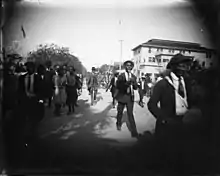Richard Aloysius Twine (May 11, 1896 – September 27, 1974) was a professional photographer in the Lincolnville section of St. Augustine, Florida (now the Lincolnville Historic District) in the 1920s. He was born in St. Augustine.[1] After five years there he moved to Miami and worked at a restaurant before establishing a hotel.[2]
In 1988 a collection of glass plate negatives was found in boxes in the attic of a house under demolition that had been Twine’s home. The collection was acquired by the St. Augustine Historical Society.[3][4]
He photographed residents of Lincolnville commemorating Emancipation Day at the annual parade in 1920.[5] He photographed an Excelsior School teacher and students at Florida Normal and Industrial Institute. His work includes a self-portrait.[6]

The University of North Florida and Lincolnville Museum have been involved in documenting subjects in the photographs as they relate to Lincolnville’s history.[2][7]
See also
- Lincolnville Museum and Cultural Center
- James Van Der Zee, photographer based in Harlem
References
- ↑ "Twine, Richard Aloysius, 1896-1974 - LC Linked Data Service: Authorities and Vocabularies | Library of Congress, from LC Linked Data Service: Authorities and Vocabularies (Library of Congress)". Library of Congress. Retrieved 13 July 2022.
- 1 2 Dumitrascu, Sarah. "Photographing Lincolnville: Richard A. Twine". The Jaxson.
- ↑ "Richard A. Twine Glass-plate Collection (79 images) – Negative, Glass Plate". St. Augustine Historical Society Research Library.
- ↑ "The city's lost (and found) treasure of Richard Twine", The St Augustine Record, March 14, 2021.
- ↑ Florida Memory. "The Forgotten History of Lincolnville." Floridiana, 2016
- ↑ Self-portrait of Richard A. Twine, Florida Memory.
- ↑ "UNF students help bring 'Lincolnville' exhibit to life". The Florida Times-Union.